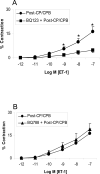Endothelin-1-induced contractile responses of human coronary arterioles via endothelin-A receptors and PKC-alpha signaling pathways
- PMID: 20079914
- PMCID: PMC2875281
- DOI: 10.1016/j.surg.2009.11.016
Endothelin-1-induced contractile responses of human coronary arterioles via endothelin-A receptors and PKC-alpha signaling pathways
Abstract
Background: We investigated the contractile function in responses to endothelin-1 (ET-1) in the human coronary microvasculature as well as the roles of endothelin receptors and protein kinase C-alpha (PKC-alpha) in these responses.
Methods: Human atrial tissue was harvested from patients who underwent cardiac surgery pre- and post-cardioplegia (CP)/cardiopulmanory bypass (CPB). Microvascular constriction was assessed in pre- and post-CP/CPB samples in responses to ET-1, in the presence and absence of an endothelin-A (ET-A) receptor antagonist, an endothelin-B (ET-B) receptor antagonist, or a PKC-alpha inhibitor, respectively. The expression and localization of the ET-A and ET-B receptors were also examined using immunoblot and immunofluorescence photomicroscopy.
Results: The post-CP/CPB contractile response of coronary arterioles to ET-1 was significantly decreased compared with the pre-CP/CPB responses. The response to ET-1 was significantly inhibited in the presence of the ET-A antagonist BQ123 (10(-7)mol/L), but these values remained unchanged with the ET-B receptor antagonist BQ788 (10(-7)mol/L). Pretreatment with the PKC-alpha inhibitor safingol (2.5 x 10(-5) mol/L) reversed the ET-1 responses from contraction into relaxation. The total polypeptide levels of ET-A and ET-B receptors were not altered post-CP/CPB. Immunoblot and immunofluorescent staining displayed strong signals for ET-A receptors and relatively weak signals for ET-B receptors localized on coronary microvasculature.
Conclusion: CP/CPB decreases the contractile function of human coronary microvessels in responses to ET-1. ET-A receptors are predominantly localized in the human coronary microcirculation, whereas ET-B receptors seem to be less abundant. The contractile response to ET-1 is in part through the activation of ET-A receptors and PKC-alpha. These results suggest a role of ET-1-induced contraction in the vasomotor dysfunction after cardiac surgery.
Copyright 2010 Mosby, Inc. All rights reserved.
Figures






References
-
- Ruel M, Khan TA, Voisine P, Bianchi C, Sellke FW. Vasomotor dysfunction after cardiac surgery. Eur J Cardiothorac Surg. 2004;26:1002–14. - PubMed
-
- Khan TA, Bianchi C, Araujo EG, Ruel M, Voisine P, Li J, Liddicoat JR, Sellke FW. Cardiopulmonary bypass reduces peripheral microvascular contractile function by inhibition of mitogen-activated protein kinase activity. Surgery. 2003;134:247–54. - PubMed
-
- Khan TA, Bianchi C, Ruel M, Voisine P, Li J, Liddicoat JR, Sellke FW. Mitogen-activated protein kinase inhibition and cardioplegia-cardiopulmonary bypass reduce coronary myogenic tone. Circulation. 2003;108(Suppl 1):II348–53. - PubMed
-
- Park KW, Dai HB, Lowenstein E, Sellke FW. Protein kinase C-induced contraction is inhibited by halothane but enhanced by isoflurane in rat coronary arteries. Anesth Analg. 1996;83:286–90. - PubMed
-
- Sodha NR, Feng J, Clements RT, Bianchi C, Boodhwani M, Ramlawi R, Mieno S, Sellke FW. Protein Kinase Cα modulates microvascular reactivity in the human coronary and skeletal microcirculation. Surgery. 2007;142:243–52. - PubMed
Publication types
MeSH terms
Substances
Grants and funding
LinkOut - more resources
Full Text Sources
Miscellaneous

